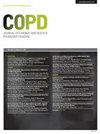肺部超声波 B 线定量作为慢性阻塞性肺疾病加重期心力衰竭标志物的价值
IF 3.1
3区 医学
Q1 Medicine
International Journal of Chronic Obstructive Pulmonary Disease
Pub Date : 2024-08-01
DOI:10.2147/copd.s447819
引用次数: 0
摘要
简介在慢性阻塞性肺疾病(AECOPD)急性加重期鉴别心力衰竭(HF)具有挑战性。目的:本研究旨在评估 LUS B 线评分(LUS 评分)在 AECOPD 患者心力衰竭诊断中的贡献:这是一项前瞻性横断面多中心队列研究,研究对象包括急诊科收治的 AECOPD 患者。所有患者均接受了肺部超声检查。根据 B 线计算评估肺部超声评分(LUS 评分)。当 LUS 评分大于 15 分时,呼吸困难的心源性原因将被保留。高血压诊断基于临床检查、前脑钠肽水平和超声心动图结果。通过接收器操作特征曲线(ROC)、灵敏度、特异性和最佳临界值的似然比来评估 LUS 评分的诊断性能:共纳入 380 例患者,平均年龄(68± 11.6)岁,男女比例(1.96)。患者分为两组:高血压组[n=157(41.4%)]和非高血压组[n=223(58.6%)]。心房颤动组的平均 LUS 评分更高(26.8± 8.4 vs 15.3±7.1;p< 0.001)。LVEF 降低的 HF 患者的平均 LUS 得分为 29.2±8.7,而 LVEF 保持的 HF 患者的平均 LUS 得分为 24.5±7.6。诊断 HF 的 LUS 评分 ROC 曲线下面积为 0.71 [0.65-0.76]。阈值为 5 时,灵敏度最高(89% [85.9- 92,1]);阈值为 30 时,特异度最高(85% [81.4- 88.6])。LUS评分与E/E'比值之间的相关性良好(R=0.46,P=0.0001):我们的研究结果表明,LUS评分可能会对AECOPD患者的心力衰竭诊断有所帮助,至少应将其作为一项排除性检查。本文章由计算机程序翻译,如有差异,请以英文原文为准。
Value of Lung Ultrasound Sonography B-Lines Quantification as a Marker of Heart Failure in COPD Exacerbation
Introduction: Identifying heart failure (HF) in acute exacerbation of chronic obstructive pulmonary disease (AECOPD) can be challenging. Lung ultrasound sonography (LUS) B-lines quantification has recently gained a large place in the diagnosis of HF, but its diagnostic performance in AECOPD remains poorly studied.
Purpose: This study aimed to assess the contribution of LUS B-lines score (LUS score) in the diagnosis of HF in AECOPD patients.
Patients and methods: This is a prospective cross-sectional multicenter cohort study including patients admitted to the emergency department for AECOPD. All included patients underwent LUS. A lung ultrasound score (LUS score) based on B-lines calculation was assessed. A cardiac origin of dyspnea was retained for a LUS score greater than 15. HF diagnosis was based on clinical examination, pro-brain natriuretic peptide levels, and echocardiographic findings. The LUS score diagnostic performance was assessed by receiver operating characteristic (ROC) curve, sensitivity, specificity, and likelihood ratio at the best cutoffs.
Results: We included 380 patients, mean age was 68± 11.6 years, sex ratio (M/F) 1.96. Patients were divided into two groups: the HF group [n=157 (41.4%)] and the non-HF group [n=223 (58.6%)]. Mean LUS score was higher in the HF group (26.8± 8.4 vs 15.3± 7.1; p< 0.001). The mean LUS score in the HF patients with reduced LVEF was 29.2± 8.7, and was 24.5± 7.6 in the HF patients with preserved LVEF. LUS score area under ROC curve for the diagnosis of HF was 0.71 [0.65– 0.76]. The best sensitivity (89% [85.9– 92,1]) was observed at the threshold of 5; the best specificity (85% [81.4– 88.6]) was observed at the threshold of 30. Correlation between LUS score and E/E’ ratio was good (R=0.46, p=0.0001).
Conclusion: Our results suggest that LUS score could be helpful and should be considered in the diagnostic approach of HF in AECOPD patients, at least as a ruling in test.
Keywords: chronic obstructive pulmonary disease, COPD, heart failure, dyspnea, lung ultrasound sonography
Purpose: This study aimed to assess the contribution of LUS B-lines score (LUS score) in the diagnosis of HF in AECOPD patients.
Patients and methods: This is a prospective cross-sectional multicenter cohort study including patients admitted to the emergency department for AECOPD. All included patients underwent LUS. A lung ultrasound score (LUS score) based on B-lines calculation was assessed. A cardiac origin of dyspnea was retained for a LUS score greater than 15. HF diagnosis was based on clinical examination, pro-brain natriuretic peptide levels, and echocardiographic findings. The LUS score diagnostic performance was assessed by receiver operating characteristic (ROC) curve, sensitivity, specificity, and likelihood ratio at the best cutoffs.
Results: We included 380 patients, mean age was 68± 11.6 years, sex ratio (M/F) 1.96. Patients were divided into two groups: the HF group [n=157 (41.4%)] and the non-HF group [n=223 (58.6%)]. Mean LUS score was higher in the HF group (26.8± 8.4 vs 15.3± 7.1; p< 0.001). The mean LUS score in the HF patients with reduced LVEF was 29.2± 8.7, and was 24.5± 7.6 in the HF patients with preserved LVEF. LUS score area under ROC curve for the diagnosis of HF was 0.71 [0.65– 0.76]. The best sensitivity (89% [85.9– 92,1]) was observed at the threshold of 5; the best specificity (85% [81.4– 88.6]) was observed at the threshold of 30. Correlation between LUS score and E/E’ ratio was good (R=0.46, p=0.0001).
Conclusion: Our results suggest that LUS score could be helpful and should be considered in the diagnostic approach of HF in AECOPD patients, at least as a ruling in test.
Keywords: chronic obstructive pulmonary disease, COPD, heart failure, dyspnea, lung ultrasound sonography
求助全文
通过发布文献求助,成功后即可免费获取论文全文。
去求助
来源期刊

International Journal of Chronic Obstructive Pulmonary Disease
RESPIRATORY SYSTEM-
CiteScore
5.10
自引率
10.70%
发文量
372
审稿时长
16 weeks
期刊介绍:
An international, peer-reviewed journal of therapeutics and pharmacology focusing on concise rapid reporting of clinical studies and reviews in COPD. Special focus will be given to the pathophysiological processes underlying the disease, intervention programs, patient focused education, and self management protocols. This journal is directed at specialists and healthcare professionals
 求助内容:
求助内容: 应助结果提醒方式:
应助结果提醒方式:


